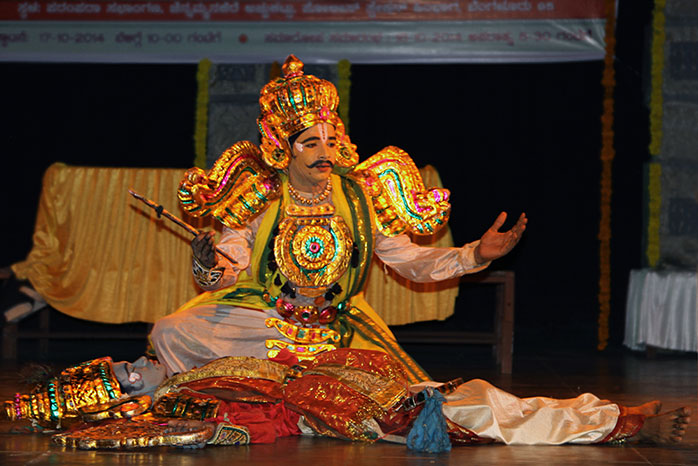The Important Aspects of Yakshagana are as following:
1. Raga:
Yakshagana Raga refers to melodic framework used in Yakshagana. It is based on pre-classical melodic forms that comprise a series of five or more musical notes upon which a melody is founded. Ragas in Yakshagana are closely associated with a set of melodic forms called mattu.
2. Tala:
Yakshagana Talaare frameworks for rhythms in Yakshagana that are determined by a poetry style called Yakshagana Padya. Tala also decide how a composition is to be enacted by the dancers. It is similar to tala in other forms of Indian music, but differs from them structurally. Each composition is set to one or more talas, rendered by the himmela percussion artist’s play.
3. Literature:
Yakshagana poetry (Yakshagana Padya or Yakshagana Prasanga) is a collection of poems written to form a music drama. The poems are composed in well-known Kannada metres, using a frame work of ragas and talas. Yakshagana also has its own metre. The collection of Yakshagana poems forming a musical drama is called a Prasanga. The narratives of the surviving historic Yakshagana Prasangas are now often printed in paperback.
4. Costumes and Ornaments:
Yakshagana costumes are rich in colour. The costumes (or vesha) in Kannada depend on characters depicted in the play (prasanga). It also depends on the Yakshagana style (tittu). Although ornaments are still predominantly made of woodwork.
Yakshagana costumes consist of headgear (Kirita or Pagade), Kavacha that decorates the chest, Buja Keerthi (armlets) that decorate the shoulders, and belts (Dabu)—all made up of light wood and covered with golden foil. Mirror work on these ornaments helps to reflect light during shows and add more colour to the costumes. Armaments are worn on a vest and cover the upper half of the body. The lower half is covered with kachche, which come in unique combinations of red, yellow, and orange checks. Bulky pads are used under the kachche, making the actors' proportions different in size from normal.
The character of Sthree Vesha makes use of sari and other decorative ornaments. Costumes give information about the performer and also aid in setting the mood. These puppets have very distinctive and elaborate costume. The costumes are made of traditional Palghat and karnad sarees with checks.
In male characters the lower pants are typical in style called the kasevastra. The top is a blouse which is hardly seen as it is covered with ornaments. One end of a shawl is tied at the back of the head gear and the other end tied to the waist. The female character wears a traditional saree. The rakshasa looks very distinctive due to his headgear which resembles the kathakali style of headgears.
5. Head Gears:
Kadaga Mundale- Head gear for heroic characters, it is a form of leaf, and initially it was made from areca frond. In past mica and wings of beetles were used to decorate the costumes these days tin foil is used, the ‘mundasu’ is another kind of head gear used by secondary characters.
6. Shoulder Plates:
Shoulder plates for heroic and demonic character respectively. There are two types of head gear, the triangular piece of cloth with conical projections. Earlier conical projections of the jumpa tree were used now they are piece.
7. Breast Plate:
Breast plate of demonic character, Breast plate of a warrior.


